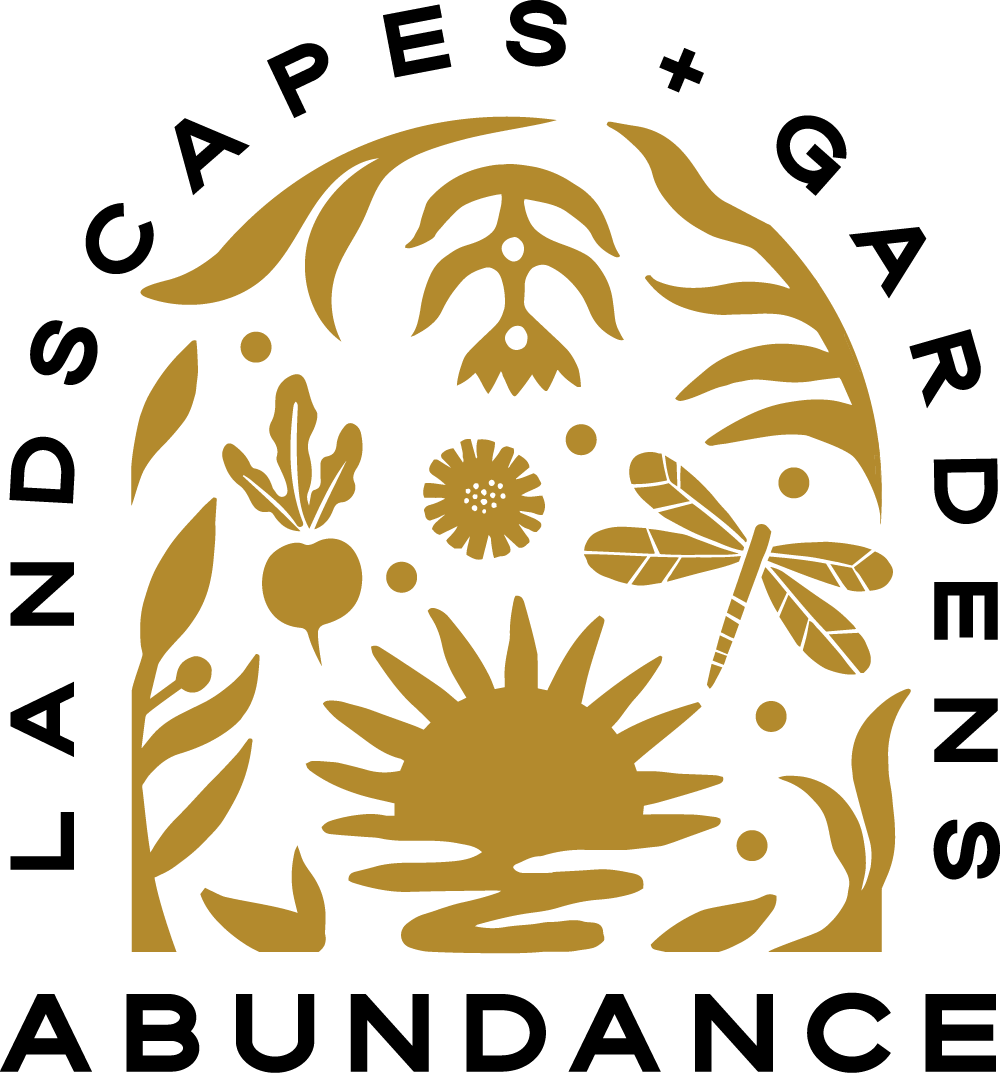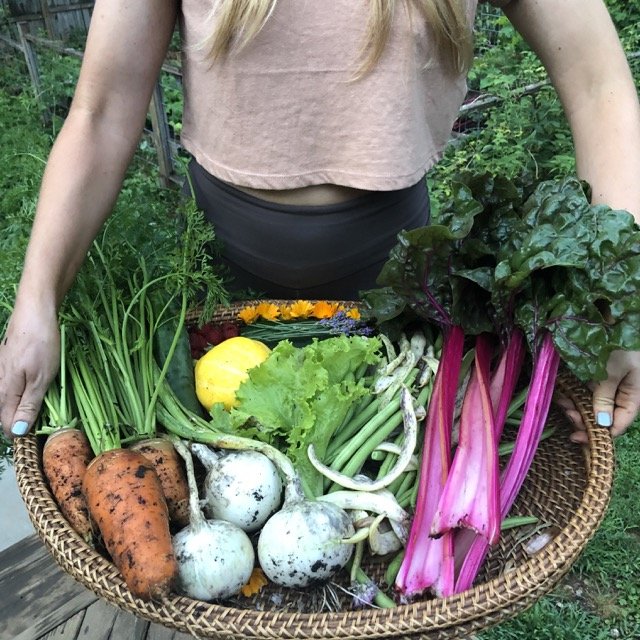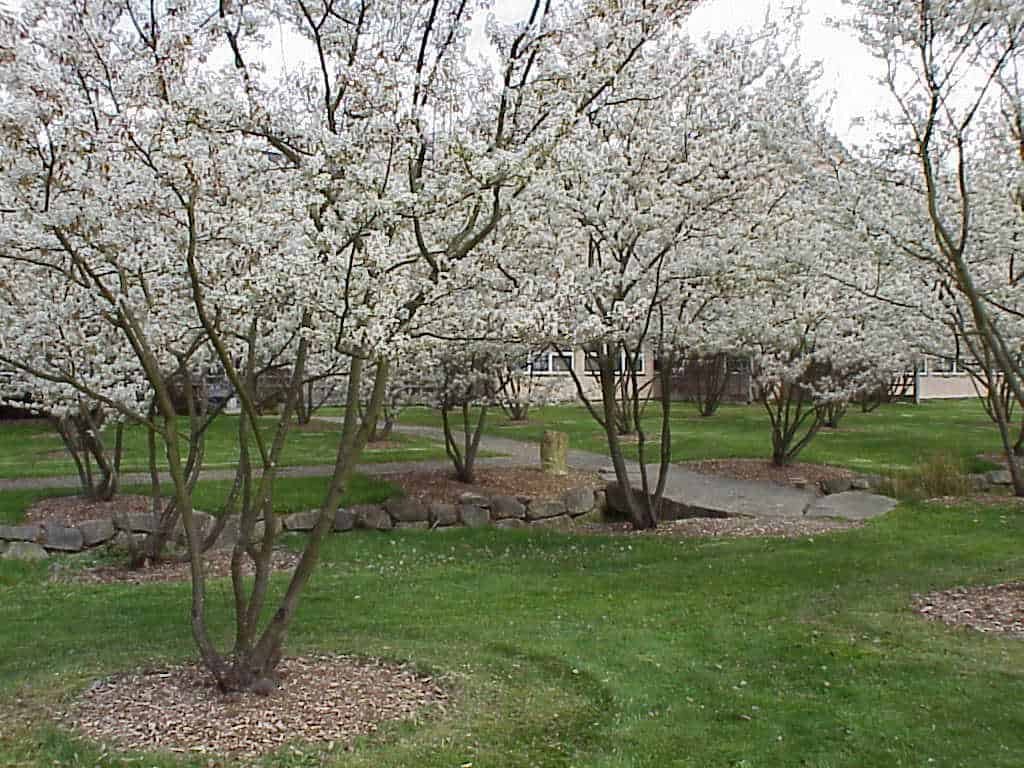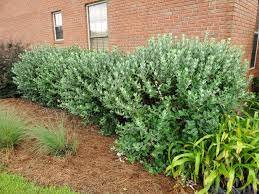November in the Garden
November brings the first wisps of frost to our Atlanta gardens, typically sometime between November 1 and November 15. Often, the frost is minimal and only temporary, but it is still crucial to be prepared! See our October in The Garden article for ways to protect your plants all Fall and Winter long. The cooler weather eases up the intensity in the vegetable garden, lessening weed pressure, pest pressure, and the need to water as much. So, what to do with all that extra time when you’re not resting? November is the time to start the more major clean ups and redesigns of the garden, and is our favorite time to shift attention to the perennial landscape, especially to our most favorite: Fruit!
What to Harvest
In Atlanta you can have a lettuce harvest over 8 months from October - May with proper care to protect it from both the cold and heat.
Greens - your Fall garden should have a variety of greens ready to harvest by November. Lettuces, arugula, kales, collards, chard, bok choy and more. Hopefully you’re not tired of all these delicious fresh greens, and also enjoying not spending $5 on a small head of lettuce. Sturdier greens can be braised, slow-cooked, roasted into chips, or sliced thinly for raw salads. Besides salads, lettuce is also a great vehicle for other foods; making lettuce wraps for veggies or a Thai Laab situation with ground meats. One of my favorite ways to use fresh greens like kale/collards/chard is to make Green Meatballs. Slice the greens into thin ribbons and sauté until just wilted with onions, garlic, and whatever other seasonings interest you. Let cool, and then mix breadcrumbs, eggs, cheese if you’re fancy, into the cooked greens. With your hands form small balls with the mixture and pan fry until golden on all sides. These Green Meatballs are great served with a creamy yogurt sauce or tomato sauce.
Roots - If you planted carrots in August, they should be ready by November. Not sure how to tell? Simply use a finger to scoot dirt away from the top of the carrot. If the carrot’s diameter seems sizable - around an inch - then wiggle it out of the soil! Not all of your carrots will develop at the same rate, so it’s always good to check the top width before harvesting. Small radishes and hakurei turnips will be ready to harvest this month as well, depending on your planting times. These roots stick their shoulders out of the soil more, so it’s easier to tell if they’re ready or not. Just judge on the size.
Sunchokes - also called Jerusalem artichokes, Sunchokes are a native sunflower variety with an edible tuber. The root vegetable tastes similar to a potato but less starchy. It can be used interchangeably with a potato. They store for about a month or so, taste great roasted or blended into soups. The root is somewhat knobby, so they can be annoying to clean at home. Expect a little grit to hang on. The plant is extremely easy to grow and requires very little maintenance. I didn’t water mine once this year. Sunchokes do spread very quickly though, so if you want larger tubers, you will need to thin out runners mid-season, so there is less competition for space and nutrition.
Herbs - November is also a lovely time to focus on your herb garden. Harvest herbs in bulk and bundle them with string so you can hang them to dry. Dry herbs can be used in soups, stocks, sauces, roasted vegetables or meats, infused into oils or salt, and so much more. Packed with all sorts of medicinal qualities, Fall is a wise time to up your herb intake to help boost your immune system.
How to Care for Your Perennials:
By leaving the seedheads of your flowers, like this coneflower, you are providing winter sustenance for native birds as well as habitat for many creatures.
Cut Back or Leave Seed Heads - Cut back yellowing or dead foliage on your perennials. If the plants have seed heads with seeds still on them, consider leaving those up for the birds! Seed heads from echinacea (coneflower), rudbekias (like black eyed susan, sochan, etc), and annual grasses are delicious and nutritious snacks for our feathered friends. Consider adding a bird feeder or three to your garden as well. You may notice at stores that there is a variety of bird seed that attracts different birds. If you can’t decide what to cut back or what to leave up, do half and half! It also is helpful to cut back anything dead that’s near a pathway to provide more access as well as tidier appearance.
Divide - This is also a great time to divide perennials. You want to divide anything that has grown beyond its boundaries, has gotten a little unruly, or something you want to spread elsewhere, or give to a friend! To divide a plant, dig it up carefully. Try to dig at least four-six inches away from the base, all the way around the plant. Lift the plant out of the ground, then gently rub the roots in your hands to loosen the soil. Looking at the top of the leaves, see if you can discern the different plants. Use your hands to grasp the different plants and then pull them a part until they are separated, each with their own roots. Transplant into the ground or into a pot as soon as possible and water in well.
Label - But before you start hacking away at clean up time for your perennial beds, this is a great time to LABEL your plants. I always regret not doing this, and then I forget what’s what, where things are, and things accidentally get forgotten or dug up or damaged. You’ll thank yourself in the Spring when things start popping up and everything is clearly labeled. A popsicle stick with pencil writing does the trick, or you can get fancy with plastic stakes, aluminum tags, etc. If you have kids, labeling is a very fun project to do together. I love getting paint stirrers from a hardware store and having kids paint them in bright colors. Once dry, the plant name can be neatly painted on or written in paint pen.
If you want to get even more serious, create a quick map of what’s planted where so you have a future reference. This will not only help you figure out who is popping up in the Spring, but also support you in figuring out if you want to put in any other additions, or if you want to move plants around to rearrange.
Clean Up
General - If you haven’t already, pull out the dead or dying annual plants from the garden. You can either yank the whole plant out, or clip the plant at the base of the stem, leaving the roots in the soil. This latter method is a good choice if you have other Fall plants growing around and do not want to disturb the soil. Most of the root material will decompose quickly and feed the soil microbes and bacteria. However, we strongly recommend removing tomato roots and any other plants that are highly susceptible to disease or can harbor bacterias and pests like nematodes.
It is also time to remove any summer trellises you aren’t using. Be sure to clean off dead vines and give the trellises a serious rinse too. Collect and toss any random garden litter like pots, twine scraps, and old plant labels. Give yourself a clean canvas.
Leaf Maintenance - Besides herbaceous plants, you’ll also be needing to do a lot of leaf cleaning, as this is the first month for substantial leaf drop. Trees are dropping their leaves in the Fall to help protect their roots throughout the cold Winter. The fallen leaves are the trees mulching themselves, giving themselves a little blanket for the cold temperatures. Without leaves, the trees can focus their energy on root development. As much as possible, I like to help the trees out and rake fallen leaves around the tree bases. However, in Atlanta, we sure got a lot of leaves to deal with in the Fall, so you may find yourself swimming in excess. A great option is to build a leaf bin to dump leaves into. They can decompose over time, or you can use them in your compost pile throughout the year as your carbon-filled “brown” material. If you want them to decompose even quicker, run over the leaves with a lawnmower to chop them up into smaller, more digestible bits. A leaf bin can simply be a large cylinder of chicken wire.
Leaves can make a great garden mulch, but I recommend keeping them out of active vegetable production gardens. Leaves can carry a lot of pests, tree seeds, or funguses, so might as well not make your life harder… So if you want to use them for mulch, opt for using them on perennials, trees, and pathways.
Tree Pruning - Pretty soon it will be a good time to prune up your fruit trees too. Wait until leaves have dropped and they have gone dormant. Fruit tree pruning can happen anywhere from late November to February. It’s a little early now, but something to begin preparing for!
What to Plant:
We recommend having a dedicated Asparagus bed as it can get a little unruly! Having it in a defined bed gives it a little more structure and aesthetic to it.
I feel like I am always planting more turnips and arugula in the Fall garden. They really don’t seem to mind. If you are using any season extension methods like low tunnels or cold frames (see October’s in the Garden article for more information), then you can definitely pop in more kale, collards, spinach and lettuces to the garden, especially if using seedlings. It may be a little difficult to get everything to establish quickly enough if directly sown.
November is also a great time to plant asparagus. I love growing asparagus. Like fruiting perennials though, asparagus do require a bit of patience as they take a few years to really get an established patch. If you have a large raised bed garden, consider devoting one full bed to asparagus. If you have an in-ground garden, choose a spot on an edge or back line to establish your asparagus patch. Asparagus, after they send up their delicious shoots in the Spring, grow very tall and create wispy grassy tufts, at least four to five feet tall. So you do not want this asparagus patch to block the sun to anything shorter behind it. In my perennial garden, my asparagus row is in between a row of sunchokes, which grow even taller than the asparagus, and a row of raspberries, which are trellised to be similar height to the asparagus. To plant asparagus, you will want asparagus crowns, which are typically available in the Fall at your local hardware/nursery store. Otherwise, you can order some online at a seed retailer. While possible, planting asparagus by seed just extends the waiting game and the germination rates tend to be spotty. After transplanting the crowns into the garden, water well and mulch heavily. You should get a few shoots in late April, which you can either harvest to enjoy or let grow to help encourage the patch to expand. The asparagus plants will spread both underground and by seed in the following years.
And of course, November is a great time to start planting all the fruit trees and vines! Planting in the Fall is ideal because plants are mostly focusing on root development over the Fall season, so your fruit tree can get its roots well-established before it needs to leaf out and flower in the Spring. There are so many wonderful fruit options to choose from in adding to your landscape, but it can be a little overwhelming to figure out! Start by figuring out how much space you have, how much sunlight there is, and what your fruit goals are! Here are some recommendations to get you started:
If you have a small space:
Nagami kumquat tree grown in a pot. They can also be grown in-ground in Atlanta with a little extra protection!
Strawberries - only needing about one foot of space, strawberry can be grown just about anywhere.
Blueberries- Blueberries need only about four to five feet of space to grow successfully. While they can grow large, it takes a while and they are very easy to prune into a small shape.
Serviceberry - if you do not have room for a large fruit tree, consider a serviceberry. While this is a tree, it has a somewhat shrublike growing habit, sending many branches up from the base. You can prune the tree however you want, and they typically do not get taller than ten feet.
Asian Pear - Asian Pears are another compact tree option. They grow larger than a serviceberry, typically eight to fifteen feet.
Blackberry-Blackberries are a vine, but only get about four to five feet tall. Some stretch longer, but will flop over pretty quickly. Trellises therefore do not need to be very tall,and a short fenceline is very suitable for blackberries. Blackberry canes will die after fruiting, so your patch requires clean up maintenance, but will stay fairly compact.
Kumquat - the smallest of citrus, kumquat trees grow 8-10 feet tall, but they can be kept smaller in a pot or with pruning. They can be grown in a pot or in ground, especially in a warmer microclimate.
If you have a large space:
Lucy and Sarah walking through our muscadine trellis - you' can also see blackberries being trellised on the fence to the right.
Fig - Figs can get huge, quickly. I recently worked at a client’s garden where they had an old fig tree the size of my house. Figs are great to fill a large corner of a lawn with or to plant on a sunny hillside.
Mulberry Trees -
Persimmon - Persimmon trees can get large, at least fifteen feet. You can prune them to stay more compact, but it will require consistent maintenance.
Paw Paw - you will need two or more for pollination. Trees can get xx
Pineapple Guava - you will need two or more for pollination. These trees can grow into large hedges or trees over time. However, they can be pruned to size as desired.
Raspberry - While one raspberry plant is fairly compact and just needs about a three to four foot trellis to hold it up, you never just have one raspberry plant. Raspberries spread very quickly and can form a large patch in no time.
Muscadine - you will want two or more for pollination. One plant can easily stretch over ten feet long. You definitely need a sizeable trellis for muscadines, the bigger the better. Just make sure you can still access the fruit!
Hardy kiwi - you will need a male and female plant for pollination. And these vines grow vigorously. You need a sturdy trellis that offer at least fifteen feet of growing space.
If you have a public space or a front yard and need to keep aesthetics up:
Serviceberry trees have gorgeous white flowers in spring and an equally breath-taking orange-red fall folliage.
Strawberry- strawberries are a lovely option for a ground cover. The dark green leaves are evergreen with some turning red in the Fall. Dead leaves will need to be cleaned up over Winter.
Pineapple guava - an evergreen shrub, pineapple guavas are a great option for a public landscape. In the Spring, their flowers are also quite striking, showing off with hot pink and creamy white blooms.
Loquat - an evergreen tree, loquats are a gorgeous choice in the landscape, especially offering more of a tropical looking aesthetic.
Evergreen blueberry - evergreen blueberries are becoming more readily available and Thyme to Party hopes to have some for purchase at our Spring Snackyard Sale. The plant is beautiful, with a cloudy pink and green ombre over the leaves. The blueberry production is not as substantial as a typical blueberry variety however.
Pomegranate - While not evergreen, pomegranates are very attractive trees. With bright red long lasting flowers that slowly morph into beautiful pale red fruits that last through the Fall, Pomegranate trees definitely grab your attention
Persimmon - While not evergreen, persimmons are an excellent choice in public landscape. They have large glossy green leaves, and the striking orange fruits can last on the tree through Fall.
If you are at a school and you want fruit while in session Aug-May:
Pineapple guavas can be grown as an evergreen edible shrub - great for front yards or more traditional landscapes!
Strawberry - strawberries fruit in May, usually right around final exams, so they make a great end of the year treat!
Serviceberry - serviceberries fruit in May, usually right around final exams, so they make a great end of the year treat. However, since many kids have not tried serviceberries before, only allow them to eat a few, so as not to trigger an allergic reaction.
Passionfruit vine - Passionfruits are ready to harvest in September. The flowers provide great intrigue for kids, as well as attract a lot of butterflies, especially as it is a host plant for the Gulf Fritillary.
Pineapple Guava - Pineapple Guavas fruit in October, so there is time to watch the fruits develop on the plant
Paw Paw- Paw Paw are typically ready to harvest in August, right as school gets back in session.
Crabapple - Ready in September, Crabapples are a great option for school gardens because they produce so many small fruits, enough for everyone!
Persimmon - Persimmons fruit in October, so there is plenty of time to watch the green fruits turn orange during the school session.
If you want somewhat fail proof and low maintenance:
Fig - Once these get established, there’s little to stop a fig tree.
Serviceberry - As a native tree, serviceberries are tough. These are often planted on sidewalks, so they can handle drought and damages.
Muscadine - As a native vine, muscadines will figure out how to survive.
If you don’t have full sun:
The Native PawPaw Tree being grown in a forested area.
Paw Paw - Paw Paws in the wild typically grow in a shady understory. To produce fruit however, they do like more sun. That’s why you may see them arching over river banks to find the light to make fruit!
Serviceberry - As a native tree often in understories or woodland edges, serviceberries can tolerate some shade, with less fruit production.
Muscadine - As a native vine, muscadines can grow just about anywhere. However they do need more sun for fruit production.
Passionfruit - As a native vine, passionfruit can also grow just about anywhere. I have even grown some to be semi-evergreen in the right microclimate. More sun means more fruit production however.
Ready to get planting? We always have some fruit trees in stock at our nursery, so hit us up for sourcing, delivery and install support. Still can’t decide which trees you want? Reach out to schedule a consultation this Fall, and we’ll help you assess your landscape, climate, and goals to figure out which trees are right for you!









